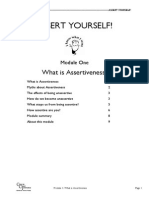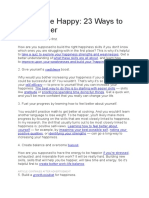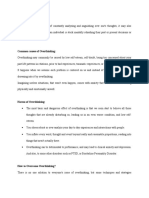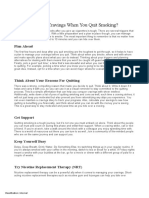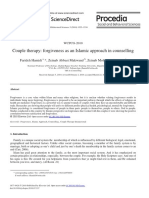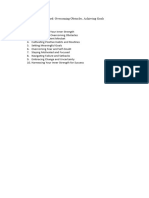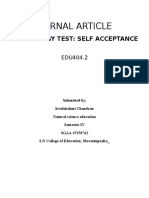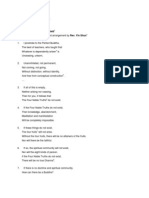Assertmodule 3
Uploaded by
Dra Lauramar Santa RiveraAssertmodule 3
Uploaded by
Dra Lauramar Santa Rivera--------------------------------------------------------------------------------------------------------------ASSERT YOURSELF!
ASSERT YOURSELF!
Module Three
How to Think More Assertively
Unassertive Thinking Our Assertive Rights How to change your beliefs Thought Diaries Behavioural Experiments Module summary About this module 2 3 4 5 10 14 15
Psychotherapy Research Training
for Centrelinical C Interventions
Module 3 How to Think More Assertively
Page 1
--------------------------------------------------------------------------------------------------------------ASSERT YOURSELF!
Unassertive thinking
As mentioned in Module 1, one of the factors that can make it difficult for us to be assertive is our thinking. We all hold beliefs about ourselves, other people and how the world works. Usually these beliefs came from our experience in the world and made sense to us at the time. However even though we have moved on from these experiences we may not have updated our thinking. For example, as a child we may have been taught by our family not to express sadness because if we did we would be ridiculed. In that situation it would have made sense for us to have the belief: expressing sadness is bad and if I do people will make fun of me. As an adult however we may still have this belief even though we are no longer in the same situation. We continue to assume that the belief is true without checking it out. As a result we may never express our sadness which may result in us being stressed, depressed and not connected with ourselves and the world. Or alternatively our sadness may be expressed as anger towards ourselves or other people. Below are listed a number of typical unassertive thoughts. See if any of them apply to you.
I shouldnt say how Im really feeling or thinking because I dont want to burden others with my problems. If I assert myself I will upset the other person and ruin our relationship It will be terribly embarrassing if I say what I think If someone says no to my request it is because they dont like or love me I shouldnt have to say what I need or how I feel: people close to me should already know It is uncaring, rude and selfish to say what you want I have no right to change my mind; neither has anyone else It will all work out in the end, and anyway its not my fault People should keep their feelings to themselves If I express that I am feeling anxious people will think I am weak and ridicule me or take advantage of me. If I accept compliments from someone it will mean I am big headed.
Psychotherapy Research Training
for Centrelinical C Interventions
Module 3 How to Think More Assertively
Page 2
--------------------------------------------------------------------------------------------------------------ASSERT YOURSELF!
Take a minute and see if you can identify any more unassertive beliefs that you have. Modules 6, 7, 8, and 9 deal with and identify unassertive thoughts associated with saying no, coping with criticism, dealing with disappointment and giving and receiving criticism, so you may get some ideas from those modules.
__________________________________________________________________________ __________________________________________________________________________ __________________________________________________________________________ __________________________________________________________________________ __________________________________________________________________________ __________________________________________________________________________
Our Assertive Rights
Many of the ideas now associated with assertiveness training were first proposed in Manuel J. Smiths book When I say No I feel Guilty published in 1975. This book outlined a tenpoint bill of assertive rights. Assertive rights are the rights that we all have as human beings. Some of these rights are: You have the right to judge your own behaviour, thoughts, and emotions, and to take the responsibility for their initiation and consequences upon yourself. You have the right to say no. You have the right to offer no reasons or excuses for justifying your behaviour. You have the right to judge if you are responsible for finding solutions to other people's problems. You have the right to change your mind. You have the right to disagree with someones opinion. You have the right to make mistakes - and be responsible for them. You have the right to say, 'I don't know'. You have the right to be illogical in making decisions. You have the right to say, 'I don't understand'. You have the right to say, 'I don't care'.
Psychotherapy Research Training
for Centrelinical C Interventions
Module 3 How to Think More Assertively
Page 3
--------------------------------------------------------------------------------------------------------------ASSERT YOURSELF!
An important part of these rights is that they come linked with responsibilities. You will notice the first point says that you have the right to your own thoughts, behaviour and emotions, but that you must then take responsibility for the consequences of these thoughts and behaviours. Often people think they are behaving assertively, but they are ignoring the consequences of their actions and the rights of others. This would be more typical of an aggressive style of communication. See if you can think of any other rights, particularly ones that balance out any unhelpful beliefs you identified in the last section.
__________________________________________________________________________ __________________________________________________________________________ __________________________________________________________________________ __________________________________________________________________________ __________________________________________________________________________ __________________________________________________________________________ __________________________________________________________________________
How to change your beliefs
Identifying your unhelpful beliefs is the first step towards changing them. In fact, for some people just realising that they have been thinking this way can be enough to help them change, especially when they realise they have the right to change and think in a different way. However, for most people just realising they have been thinking in an unhelpful way isnt enough to change the thinking. In Cognitive Behaviour Therapy (CBT) one way of addressing unhelpful thoughts is to challenge them head on. This is also called disputation. Challenging or disputation works on the principle that most of our thoughts and beliefs are learned opinions rather than facts. This means that they can be questioned rather than just accepted blindly, particularly if they are causing us distress. To challenge or dispute your thoughts means that you examine the evidence for and against the thoughts. You evaluate them as if you were a detective or a lawyer. You are trying to get to the bottom of the truth of the thought.
for Centrelinical C Interventions
Module 3 How to Think More Assertively
Page 4
Psychotherapy Research Training
--------------------------------------------------------------------------------------------------------------ASSERT YOURSELF!
There are two major strategies that can be used to help you challenge your thoughts. One is to use a Thought Diary. The other is to set up a Behavioural Experiment. We will take a look at each of these in turn.
Thought Diaries
It can be difficult to challenge your thoughts in your head as it is hard to remember all the information and it can get messy and confusing. The best way is to write it all down. To help you through this process we have a Thought Diary for Unassertive Thoughts. We have worked through an example to show you the questions that you will need to ask yourself in order to come up with a more balanced thought. Then we provide a blank one for you to work through with an example of your own. The thought diary will ask you to identify the unassertive thought that you are having. In order to do this you first need to identify the situation you are in. In the following example the situation could be described as: I asked my friend to go shopping and she said no. In describing the situation think about what you would have seen if you had been filming the scene. It is important that you just stick to the facts and dont start making interpretations about what this may mean at this stage. For example, you wouldnt say my friend was rude to me as this is an assumption and an interpretation that we dont have any evidence for yet. Next you need to identify your emotions in the situation, that is, how you are feeling. Ask yourself: What emotion(s) am I feeling? How intense are they? (rate the intensity from 0-100). In the following example the person feels hurt and annoyed. The ratings are done individually for each emotion; they dont need to add up to 100. You then identify your behaviour and any physical symptoms that you felt. Ask yourself: What did I do? What did I feel in my body?
Psychotherapy Research Training
for Centrelinical C Interventions
Module 3 How to Think More Assertively
Page 5
--------------------------------------------------------------------------------------------------------------ASSERT YOURSELF!
In the following example the person ignored a phone call from her friend and felt tense and sick whenever she thought about the situation. Next you need to identify your thoughts in the situation. These thoughts can take the forms of assumptions, interpretations, beliefs, values and so on. Sometimes they could even take the form of images or pictures rather than words. Ask yourself: What was I thinking? What was running through my head? In the example the persons thoughts were: I said yes to go shopping with her when I didnt want to. So she should have said yes to me Saying No is rude, uncaring and selfish. Maybe she doesnt like me any more. You then need to rate the strength of your beliefs in these thoughts at the time. A rating of 0 means you didnt believe them at all and a rating of 100 means you believed them 100%. Once you have completed this first part of the Thought Diary you move onto the disputation. The questions you ask yourself in the disputation are: Am I thinking in a passive, assertive or aggressive way? Did I respond in a passive, assertive or aggressive way? What is the evidence for this thought? What is the evidence against this thought? Am I ignoring my rights or the rights of my friends? How else could I view the situation? Are there any other interpretations of what happened? The idea behind asking yourself these questions is to come up with a more balanced and assertive way of thinking and behaving. You ask yourself: What would be a more assertive way of thinking and responding? The final step is to re-rate the intensity of the original emotion and strength of the belief. If you have worked through the entire thought diary it is likely that you will
for Centrelinical C Interventions
Module 3 How to Think More Assertively
Page 6
Psychotherapy Research Training
--------------------------------------------------------------------------------------------------------------ASSERT YOURSELF!
experience a decrease in the intensity of the emotion and a decrease in the degree to which you believe your initial unhelpful thought. If you continue to practice this way of thinking you can find that you begin thinking and behaving in a more assertive manner. Thought Diary: Part 1 Understanding your reaction.
Situation: What emotions was I feeling? How strong were these? Rate (0-100) What physical response did I notice in my body? What did I do? Was this a passive, assertive or aggressive way of behaving? What thoughts were running through my head? Which is the strongest thought? How much do I believe this thought? Are these passive, assertive or aggressive thoughts? I asked a friend to go shopping with me and she said no. Hurt 70 Angry 80 Tense, tight chest, clenched jaw. Felt sick when I thought about her. Cried, then ignored the next phone call I had from her. Passive-aggressive I said yes to go shopping with her when I didnt want to. So she should have said yes to me She is selfish to say no. Maybe she doesnt like me anymore. She is selfish for saying No. 80 Passive because I thought I should do something I didnt want to do. Aggressive that I think she should do what I want her to.
Part 2: Disputing or challenging your unassertive thoughts
Is there any evidence that my thought is true? Is there any evidence that my thought is not true? Am I ignoring my rights or the rights of the other person? If so, what am I ignoring? Are there any other ways of interpreting the situation? None She has done lots of things with me and for me over the course of our friendship. Yes, I ignored my rights by saying yes when I didnt want to go shopping. And I am ignoring her rights by acting as if she has to do what I want. The right I am ignoring is everyone has the right to say no. She may be tired She may not want to go shopping She may have something else on Im mind-reading what she is thinking. Ive said no to her sometimes and that didnt mean that I didnt like her. She has a right to say no and that doesnt mean she is selfish. Nor does it say anything about what she may or may not think about me. I will suggest catching up another time doing something that we both like. Hurt 20 Angry 10 Belief: 10
What would be a more assertive way to think about this? What would be a more assertive way to behave? Rerate my original emotion: Rerate my belief in the original thought:
Psychotherapy Research Training
for Centrelinical C Interventions
Module 3 How to Think More Assertively
Page 7
--------------------------------------------------------------------------------------------------------------ASSERT YOURSELF!
Try using a Thought Diary for Unassertive Behaviour next time you notice that you are feeling hurt, angry or upset after an interaction with someone. It may be that you have thought and /or reacted in an unassertive manner. Continue to use a Thought Diary for these situations until it becomes second nature to you. You will then find that you can catch your unassertive thoughts before you act on them and dispute them in your head. This can take some time to happen, so for now continue to practice disputation in a Thought Diary. Now try a Thought Diary of your own. There is a blank one on the next page:
Psychotherapy Research Training
for Centrelinical C Interventions
Module 3 How to Think More Assertively
Page 8
--------------------------------------------------------------------------------------------------------------ASSERT YOURSELF!
Thought Diary: Part 1 Understanding your reaction. Situation: What emotions was I feeling? How strong were these? Rate (0-100) What physical response did I notice in my body? What did I do? Was this a passive, assertive or aggressive way of behaving? What thoughts were running through my head? Which is the strongest thought? How much do I believe this thought? Are these passive, assertive or aggressive thoughts? Part 2: Disputing or challenging your unassertive thoughts Is there any evidence that my thought is true? Is there any evidence that my thought is not true? Am I ignoring my rights or the rights of the other person? If so, what am I ignoring? Are there any other ways of interpreting the situation? What would be a more assertive way to think about this? What would be a more assertive way to behave? Rerate my original emotion: Rerate my belief in the original thought:
Psychotherapy Research Training
for Centrelinical C Interventions
Module 3 How to Think More Assertively
Page 9
--------------------------------------------------------------------------------------------------------------ASSERT YOURSELF!
Behavioural Experiments
Doing a Thought Diary can help us change our beliefs about a situation. This is especially true when we write then down and practise our new thoughts over and over again. Sometimes however it is hard for us to shift our beliefs when all we are doing is writing down our thoughts. We might see that it makes sense logically but feel inside that nothing has really changed. Thought Diaries may also be difficult to use when there is no real evidence for or against a particular situation. For example, we may have the belief that if we dont always do what someone else wants us to do then they wont like us anymore. We are unlikely to put ourselves in this situation to test this out so doing a Thought Diary on its own is unlikely to really convince us simply because we have no real evidence either way. What may be more useful in this situation is to do a Behavioural Experiment. We are still trying to change our beliefs but whereas a Thought Diary helps us change beliefs by thinking differently about the belief, a Behavioural Experiment helps us change beliefs by actually giving us some evidence to support a new belief. For example, someone may have the belief: If I assert myself then I will upset the other person and ruin our relationship. This belief has meant that the person has always gone along with what others suggest even thought it may be the complete opposite of what they really want to do. They believe it so much they have never considered trying to assert themselves. They have completed some Thought Diaries and realised that they dont really have any evidence to support their belief. However, neither do they have any evidence against it so they feel a bit stuck. They decide that one way they can find out is to do an experiment where they actually test their prediction that the other person will be upset and the relationship will be ruined. This will be a challenge and can be quite anxiety provoking. When deciding to do an experiment it is important that you plan it carefully so that the results will be clear. Also you may need to start with an easier experiment and then build up to more difficult situations. The following example is an experiment to test the belief: If I assert myself then I will upset the other person and ruin our relationship.
Psychotherapy Research Training
for Centrelinical C Interventions
Module 3 How to Think More Assertively
Page 10
--------------------------------------------------------------------------------------------------------------ASSERT YOURSELF!
The first step is to identify the prediction that you have about the situation and how you will know if it has happened. This is an important step, as if you dont make it clear how you will know it has happened then you can easily shift the goal posts after the experiment. You also need to identify any unassertive or unhelpful behaviours that you would normally do so that you can make sure that you dont do these during the experiment. Then you need to make some more helpful predictions about what may happen. These can come from having done a Thought Diary beforehand or you may be able to identify them without having done a Thought Diary. You then set up the experiment. This involves being very clear about the steps you will take. Make it clear when, where and how you will do the experiment. This includes identifying some more helpful behaviours that you will do during the experiment. You then do the experiment and evaluate the results. Ask yourself: What happened? Were your original predictions supported? What did you learn from the experiment?
Psychotherapy Research Training
for Centrelinical C Interventions
Module 3 How to Think More Assertively
Page 11
--------------------------------------------------------------------------------------------------------------ASSERT YOURSELF!
Example Behavioural experiment Step 1. Identify the prediction.
The situation My prediction How much do I believe it will happen? (0-100%) How will I know it has happened? Telling my friend I dont want to go shopping with her. She will be upset and angry and not want to be my friend anymore 70% She will hang up on me and not return my calls or ring me.
Step 2: Identify my unhelpful behaviours
What unhelpful behaviours would I normally engage in to cope (e.g. avoidance, escape, safety behaviours) Make up excuses, pretend to be sick, avoid her until it is too late.
Step 3: Identify a more realistic prediction
Remind myself of the more realistic prediction I have made (can be from a Thought Diary) She has said no to me before and that was fine. She may be disappointed but if she is a good friend she wont be angry and our friendship will be fine.
Step 4:Identify my helpful behaviours and set up my experiment
What will I do differently to test out the two predictions? Instead of avoiding her I will ring her today first thing and explain that I have a meeting I need to prepare for so dont want to go shopping. I will organise another time to catch up with her.
Step 5: carry out the experiment. Step 6: Evaluate the results
What actually happened? How much did my original prediction come true? (0100%) Which prediction was supported? What was it like to behave differently? What did you learn from the experiment? She said it was fine and in fact suited her too. We made a time for a coffee next week. 0% The more realistic one. Scary, difficult at first, got easier. I tend to expect the worst and this has kept me behaving in a passive way. It felt good to be honest and direct. Being assertive doesnt mean that people will be upset with you and if they are then that is their problem to work on.
Overleaf is a blank experiment sheet for you to work through with one of your unassertive predictions.
Psychotherapy Research Training
for Centrelinical C Interventions
Module 3 How to Think More Assertively
Page 12
--------------------------------------------------------------------------------------------------------------ASSERT YOURSELF!
My Behavioural experiment Step 1. Identify the prediction. The situation My prediction How much do I believe it will happen? (0-100%) How will I know it has happened? Step 2: Identify my unhelpful behaviours What unhelpful behaviours would I normally engage in to cope (e.g. avoidance, escape, safety behaviours) Step 3: Identify a more realistic prediction Remind myself of the more realistic prediction I have made (can be from a Thought Diary) Step 4: Identify my helpful behaviours and set up my experiment What will I do differently to test out the two predictions? Step 5: Carry out the experiment. Step 6: Evaluate the results What actually happened? How much did my original prediction come true? (0-100%) Which prediction was supported? What was it like to behave differently? What did you learn from the experiment?
Psychotherapy Research Training
for Centrelinical C Interventions
Module 3 How to Think More Assertively
Page 13
--------------------------------------------------------------------------------------------------------------ASSERT YOURSELF!
Module summary
Our thinking can sometimes stop us from behaving assertively. Being assertive involves a number of rights but also a number of responsibilities. We have a responsibility to ourselves and also to the people we are interacting with. We can change our non-assertive thinking by using Cognitive Behaviour Therapy. Techniques include using a Thought Diary or doing a Behavioural Experiment.
The next module introduces some assertiveness techniques.
Psychotherapy Research Training
for Centrelinical C Interventions
Module 3 How to Think More Assertively
Page 14
--------------------------------------------------------------------------------------------------------------ASSERT YOURSELF!
ABOUT THIS MODULE
CONTRIBUTORS
Fiona Michel (MPsych1 PhD2). Centre for Clinical Interventions
1
Dr Anthea Fursland (PhD2) Centre for Clinical Interventions
Master of Psychology (Clinical Psychology) 2Doctor of Philosophy (Clinical Psychology)
We would also like to thank Paula Nathan for her contribution to these modules
BACKGROUND
The concepts and strategies in the modules have been developed from evidence based psychological practice, primarily Cognitive-Behaviour Therapy (CBT). CBT is a type of psychotherapy that is based on the theory that unhelpful negative emotions and behaviours are strongly influenced by problematic cognitions (thoughts). This can be found in the following: Beck, A.T., Rush, A. J., Shaw, B.F., & Emery, G. (1979). Cognitive Therapy of Depression. New York:Guildford. Clark, D. M. (1986). A cognitive approach to panic. Behaviour Research and Therapy, 24, 461-470. Clark, D. M. & Wells, A. (1995). A cognitive model of social phobia. In R. Heimberg, M. Liebowitz, D.A.
REFERENCES
These are some of the professional references used to create this module: Alberti, R. & Emmons, M. (1974). Your Perfect Right. Impact, San Luis Obispo, California. Back, R & Back, K. (1986). Assertiveness at Work A Practical guide to Handling Awkward Situations. McGraw Hill, London. Gambrill, E.D. & Richey, L.A. (1975). An assertion inventory for use in assessment and research. Behavior Therapy, 6, 550-561. Holland, S. & Ward, C. (1980). Assertiveness: A Practical Approach. Winslow Press, Bicester. Linehan, M. (1979). Structured cognitive-behavioural treatment of assertion problems. In Kendall & Hollon, Cognitive Behavioural Interventions (pp205-240). Academic Press. McKay, M & Fanning, P. (1995). Self esteem, third edition. St Martins Paperbacks, California. Powell, T. (2000). The Mental Health Handbook (revised edition). Speechmark Publishing, Wesleyan University Press. Smith, M.J. (1975). When I Say No I Feel Guilty. Dial, New York. Wolpe, J. (1973). The Practice of Behavior Therapy. Pergamon Press, New York.
ASSERT YOURSELF
This module forms part of: Michel, F. (2008). Assert Yourself. Perth, Western Australia: Centre for Clinical Interventions. ISBN: 0-9757995-5-X Created: November, 2008
Psychotherapy Research Training
for Centrelinical C Interventions
Module 3 How to Think More Assertively
Page 15
You might also like
- Chapter 1 An Overview of Human Behavior in Organization100% (9)Chapter 1 An Overview of Human Behavior in Organization35 pages
- How Healthy Is YOUR Relationship With God TAKE THE QUIZNo ratings yetHow Healthy Is YOUR Relationship With God TAKE THE QUIZ5 pages
- Once Hurt, Twice Shy - Social Pain Contributes To Social AnxietyNo ratings yetOnce Hurt, Twice Shy - Social Pain Contributes To Social Anxiety9 pages
- Assert Yourself - 09 - Giving and Receiving Compliments AssertivelyNo ratings yetAssert Yourself - 09 - Giving and Receiving Compliments Assertively9 pages
- How To Be Happy: 23 Ways To Be Happier: Article Continues After AdvertisementNo ratings yetHow To Be Happy: 23 Ways To Be Happier: Article Continues After Advertisement5 pages
- Beautiful Boy Movie Reflection QuestionsNo ratings yetBeautiful Boy Movie Reflection Questions1 page
- PDF Thoughts and Feelings 5th ed Workbook CBT for worry control panic depression phobias anger stress habits 5th Edition Matthew Mckay download100% (1)PDF Thoughts and Feelings 5th ed Workbook CBT for worry control panic depression phobias anger stress habits 5th Edition Matthew Mckay download40 pages
- Difference Between Unhealthy and Healthy CommunicationNo ratings yetDifference Between Unhealthy and Healthy Communication3 pages
- Assert Yourself - 01 - What Is AssertivenessNo ratings yetAssert Yourself - 01 - What Is Assertiveness9 pages
- Conflict: Healthy and Unhealthy Ways of Managing and Resolving CNo ratings yetConflict: Healthy and Unhealthy Ways of Managing and Resolving C4 pages
- Download Complete An Emotionally Focused Workbook for Couples: The Two of Us 1st Edition, (Ebook PDF) PDF for All Chapters100% (2)Download Complete An Emotionally Focused Workbook for Couples: The Two of Us 1st Edition, (Ebook PDF) PDF for All Chapters61 pages
- How To Manage Cravings When You Quit SmokingNo ratings yetHow To Manage Cravings When You Quit Smoking2 pages
- Overcoming Guilt and Shame - Simple Solutions To Move Past Guilt, Shame, and More! (PDFDrive)No ratings yetOvercoming Guilt and Shame - Simple Solutions To Move Past Guilt, Shame, and More! (PDFDrive)67 pages
- Couple Therapy Forgiveness As An Islamic Approach in CounsellingNo ratings yetCouple Therapy Forgiveness As An Islamic Approach in Counselling6 pages
- The Problem Is My Partner - Treating Couples When One Partner WantNo ratings yetThe Problem Is My Partner - Treating Couples When One Partner Want32 pages
- Values Assessment: Most Important Least ImportantNo ratings yetValues Assessment: Most Important Least Important3 pages
- Factors Strengthening Marriage A Review On What Binds Couples Together-2019-01!09!10-12No ratings yetFactors Strengthening Marriage A Review On What Binds Couples Together-2019-01!09!10-1210 pages
- The Twelve Step Program - Big Book Guide: It Only Takes A Day To Learn 'How It Works' and A Lifetime To Practice It!100% (1)The Twelve Step Program - Big Book Guide: It Only Takes A Day To Learn 'How It Works' and A Lifetime To Practice It!30 pages
- College Anxiety: How To Help An Anxious Student Transition SuccessfullyNo ratings yetCollege Anxiety: How To Help An Anxious Student Transition Successfully5 pages
- Anger Management: From The Book "The Other Side of Love" by Dr. Gary Chapman: Afjrotc100% (1)Anger Management: From The Book "The Other Side of Love" by Dr. Gary Chapman: Afjrotc90 pages
- What Does Research Tell Us About Healthy RelationshipsNo ratings yetWhat Does Research Tell Us About Healthy Relationships4 pages
- Sobriety Plan: Physically Maintain Sobriety, I NeedNo ratings yetSobriety Plan: Physically Maintain Sobriety, I Need1 page
- Self-Confidence For Beginners: Master Self-Esteem, Beat Depression & Insecurity, Develop Powerful Habits & Change Your LifeFrom EverandSelf-Confidence For Beginners: Master Self-Esteem, Beat Depression & Insecurity, Develop Powerful Habits & Change Your LifeNo ratings yet
- Magic Thoughts (1637 +) to Free Yourself From the Grip of Anger and Get More Out of LifeFrom EverandMagic Thoughts (1637 +) to Free Yourself From the Grip of Anger and Get More Out of LifeNo ratings yet
- Stanley I. Benn - A Theory of Freedom (2009 (1988), Cambridge University Press) - Libgen - Li100% (1)Stanley I. Benn - A Theory of Freedom (2009 (1988), Cambridge University Press) - Libgen - Li353 pages
- Edited by Ronald Cole-Turner Transhumanism and Transcendence Christian Hope in An Age of Technological Enhancement 2011No ratings yetEdited by Ronald Cole-Turner Transhumanism and Transcendence Christian Hope in An Age of Technological Enhancement 2011228 pages
- Esoteric Development: Selected Lectures and Writings From The Works of Rudolf SteinerNo ratings yetEsoteric Development: Selected Lectures and Writings From The Works of Rudolf Steiner53 pages
- Michel Henry The Genealogy of Psychoanalysis 1985No ratings yetMichel Henry The Genealogy of Psychoanalysis 1985192 pages
- A Constructivist View of Science EducationNo ratings yetA Constructivist View of Science Education1 page
- Test Paper Name, Surname - The XI-th Form I. Read The Text and Accomplish The Post-Reading Tasks. The Yin Yang SignificanceNo ratings yetTest Paper Name, Surname - The XI-th Form I. Read The Text and Accomplish The Post-Reading Tasks. The Yin Yang Significance3 pages
- Chapter 4 - Lesson 1 (Happiness and Ultimate Purpose)No ratings yetChapter 4 - Lesson 1 (Happiness and Ultimate Purpose)1 page
- Gallagher On Macintyre Three Rival VersionsNo ratings yetGallagher On Macintyre Three Rival Versions5 pages
- Download ebooks file Essay on a New Theory of the Human Capacity for Representation 1st Edition Karl Leonhard Reinhold all chapters100% (1)Download ebooks file Essay on a New Theory of the Human Capacity for Representation 1st Edition Karl Leonhard Reinhold all chapters67 pages
- The AIM and Way of Life - by Ven. DR K Sri DhammanandaNo ratings yetThe AIM and Way of Life - by Ven. DR K Sri Dhammananda8 pages
- Chapter 1 An Overview of Human Behavior in OrganizationChapter 1 An Overview of Human Behavior in Organization
- How Healthy Is YOUR Relationship With God TAKE THE QUIZHow Healthy Is YOUR Relationship With God TAKE THE QUIZ
- Once Hurt, Twice Shy - Social Pain Contributes To Social AnxietyOnce Hurt, Twice Shy - Social Pain Contributes To Social Anxiety
- Assert Yourself - 09 - Giving and Receiving Compliments AssertivelyAssert Yourself - 09 - Giving and Receiving Compliments Assertively
- How To Be Happy: 23 Ways To Be Happier: Article Continues After AdvertisementHow To Be Happy: 23 Ways To Be Happier: Article Continues After Advertisement
- PDF Thoughts and Feelings 5th ed Workbook CBT for worry control panic depression phobias anger stress habits 5th Edition Matthew Mckay downloadPDF Thoughts and Feelings 5th ed Workbook CBT for worry control panic depression phobias anger stress habits 5th Edition Matthew Mckay download
- Difference Between Unhealthy and Healthy CommunicationDifference Between Unhealthy and Healthy Communication
- Conflict: Healthy and Unhealthy Ways of Managing and Resolving CConflict: Healthy and Unhealthy Ways of Managing and Resolving C
- Download Complete An Emotionally Focused Workbook for Couples: The Two of Us 1st Edition, (Ebook PDF) PDF for All ChaptersDownload Complete An Emotionally Focused Workbook for Couples: The Two of Us 1st Edition, (Ebook PDF) PDF for All Chapters
- Overcoming Guilt and Shame - Simple Solutions To Move Past Guilt, Shame, and More! (PDFDrive)Overcoming Guilt and Shame - Simple Solutions To Move Past Guilt, Shame, and More! (PDFDrive)
- Couple Therapy Forgiveness As An Islamic Approach in CounsellingCouple Therapy Forgiveness As An Islamic Approach in Counselling
- The Problem Is My Partner - Treating Couples When One Partner WantThe Problem Is My Partner - Treating Couples When One Partner Want
- Factors Strengthening Marriage A Review On What Binds Couples Together-2019-01!09!10-12Factors Strengthening Marriage A Review On What Binds Couples Together-2019-01!09!10-12
- The Twelve Step Program - Big Book Guide: It Only Takes A Day To Learn 'How It Works' and A Lifetime To Practice It!The Twelve Step Program - Big Book Guide: It Only Takes A Day To Learn 'How It Works' and A Lifetime To Practice It!
- College Anxiety: How To Help An Anxious Student Transition SuccessfullyCollege Anxiety: How To Help An Anxious Student Transition Successfully
- Anger Management: From The Book "The Other Side of Love" by Dr. Gary Chapman: AfjrotcAnger Management: From The Book "The Other Side of Love" by Dr. Gary Chapman: Afjrotc
- What Does Research Tell Us About Healthy RelationshipsWhat Does Research Tell Us About Healthy Relationships
- Sobriety Plan: Physically Maintain Sobriety, I NeedSobriety Plan: Physically Maintain Sobriety, I Need
- Self-Confidence For Beginners: Master Self-Esteem, Beat Depression & Insecurity, Develop Powerful Habits & Change Your LifeFrom EverandSelf-Confidence For Beginners: Master Self-Esteem, Beat Depression & Insecurity, Develop Powerful Habits & Change Your Life
- Magic Thoughts (1637 +) to Free Yourself From the Grip of Anger and Get More Out of LifeFrom EverandMagic Thoughts (1637 +) to Free Yourself From the Grip of Anger and Get More Out of Life
- The Book of Love: The Essential Guide to RelationshipsFrom EverandThe Book of Love: The Essential Guide to Relationships
- Cognitive Behavioral Therapy Made Simple (2 Books in 1)From EverandCognitive Behavioral Therapy Made Simple (2 Books in 1)
- Stanley I. Benn - A Theory of Freedom (2009 (1988), Cambridge University Press) - Libgen - LiStanley I. Benn - A Theory of Freedom (2009 (1988), Cambridge University Press) - Libgen - Li
- Edited by Ronald Cole-Turner Transhumanism and Transcendence Christian Hope in An Age of Technological Enhancement 2011Edited by Ronald Cole-Turner Transhumanism and Transcendence Christian Hope in An Age of Technological Enhancement 2011
- Esoteric Development: Selected Lectures and Writings From The Works of Rudolf SteinerEsoteric Development: Selected Lectures and Writings From The Works of Rudolf Steiner
- Test Paper Name, Surname - The XI-th Form I. Read The Text and Accomplish The Post-Reading Tasks. The Yin Yang SignificanceTest Paper Name, Surname - The XI-th Form I. Read The Text and Accomplish The Post-Reading Tasks. The Yin Yang Significance
- Chapter 4 - Lesson 1 (Happiness and Ultimate Purpose)Chapter 4 - Lesson 1 (Happiness and Ultimate Purpose)
- Download ebooks file Essay on a New Theory of the Human Capacity for Representation 1st Edition Karl Leonhard Reinhold all chaptersDownload ebooks file Essay on a New Theory of the Human Capacity for Representation 1st Edition Karl Leonhard Reinhold all chapters
- The AIM and Way of Life - by Ven. DR K Sri DhammanandaThe AIM and Way of Life - by Ven. DR K Sri Dhammananda







